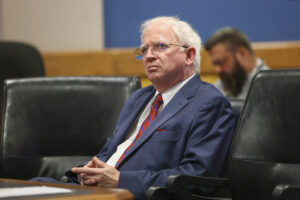What If Indigenous Women Ran Controlled Burns?
The Karuk Tribe’s first-of-its-kind training seeks to extinguish hypermasculinity in firefighting culture. During the first Karuk Women’s TREX, an engine crew works together to tame the flames climbing a tanoak tree.
Ren Brownell/Courtesy of Karuk Women’s TREX.
During the first Karuk Women’s TREX, an engine crew works together to tame the flames climbing a tanoak tree.
Ren Brownell/Courtesy of Karuk Women’s TREX.
This article was originally published in High Country News.
It was Saturday, a hot one. In the remote mountains of Northern California, a group of mostly Indigenous women took a break from conducting prescribed burns. Some sat on mats in the early October shade, pounding woodwardia fern, splitting maidenhair ferns and weaving the stems into baskets, while others stood at a stump by the fire pit, using a wooden paddle to stir hot rocks into a big pot of acorn soup, steaming it from within. Salmon heads and fillets smoked on stakes around a fire pit. Children ran and shrieked until scolded by elders, who were listening to cultural presentations about prescribed fire and weaving. This was the midpoint of the two-week inaugural Karuk Women’s TREX, or prescribed fire training exchange—the first-ever such training tailored specifically for Indigenous women.Historically, in Káruk society, women were responsible for maintaining village areas with fire. Men burned, too, but farther away, usually on remote hunting grounds. But cultural fire was suppressed in 1911, when the Weeks Act outlawed igniting fires on public lands. Today, that colonialist law is still considered a conservation landmark.
Recently, however, prescribed burns have gained favor with the Forest Service, and in 2008, it worked with The Nature Conservancy and several agencies from the Department of the Interior to organize the first TREX. They’ve occurred around the country ever since.
The events spread the theory and practice of prescribed burning. But they are also a way to change mainstream fire culture, which has long been “very exclusive, very militaristic, very socially and culturally homogenous,” said Lenya Quinn-Davidson, fire advisor for the University of California Cooperative Extension and director of the Northern California Prescribed Fire Council. The U.S. still tends to see fire as a battlefield adversary and has long rejected using intentional burns as tools for forest management; many of modern firefighting’s tactics and tools have military roots. Prescribed burns typically follow the hierarchical incident command system for safe operation management. Daily briefings before burns are peppered with military jargon: The land to be burned is called the “unit,” teams are “squads,” and the final dousing of embers is the “mop-up,” a term the U.S. Marines sometimes use to describe capturing or slaughtering holdouts after battle.
Indigenous women traveled from communities across the continent to attend the event and share their knowledge
Fire management is predominantly white and around 90% male, Quinn-Davidson said. So, to counterbalance the militaristic, hyper-masculine firefighting culture, she has hosted five women’s training exchanges since 2016. These aim to be 90% women, and participation demand is high. This time, she collaborated with Káruk organizers like Vikki Preston, a cultural resources technician at the tribe’s Department of Natural Resources, to tailor a TREX specifically for Native women. It wasn’t exclusive, said Preston, who is Káruk, Yurok, Paiute and Pit River. “But for the most part, we really tried to go through and pick Native women and femmes and nonbinary folks.”
Preston, who’s also a weaver, described the Karuk Women’s TREX as a prescribed burn with cultural objectives. “Prescribed burning is a lot about simply, purely fuels reduction,” she said, whereas cultural burning involves cultivating resources for food and basketry, tending to ceremonial grounds, maintaining forest access and other cultural needs that prescribed burns often overlook.
Preston consulted with elders and tailored the burn plan to nurture Káruk basketry plants: river willow, hazel shoots and ceanothus, which provide a basket’s structure; jet-black maidenhair fern, sun-bleached beargrass and woodwardia fern, which is dyed red with alderwood bark for a zing of color. These plants benefit from fire, which kills pests and encourages new growth of straight and tender shoots. After too long without fire, the plants become crooked, brittle and unusable.
As one of the burn’s ranking organizers, Preston held the title of “Incident Commander,” which she pronounced with air quotes and an eye roll: “Ugh. I hate to use that word.” The patriarchal military jargon of a typical TREX, however, isn’t set in stone; the first term the Karuk Women’s TREX changed was “mop-up,” replacing it with íship, Káruk for “extinguish.”
“We’ve changed one word so far,” said Preston. “But there’s so many.”
Indigenous women traveled from communities across the continent — even from as far as Australia — to attend the event and share their knowledge. During one morning briefing, an Anishinaabe woman from Thunder Bay, Ontario, spoke with Indigenous Australian fire practitioners about the legal implications of burning on federal land versus “crown land” — land the British monarch has laid claim to. It was a conversation born out of the women’s shared colonial conditions.
“For such a long time, it has always been just old white fellas that were burning our lands and had no idea of what was there and what was sacred to us,” said Kylee Clubb, a Gambir Yidinji cultural heritage protection officer and volunteer firefighter with Queensland Fire and Emergency Services.
“The vision for me as a cultural fire practitioner is to come into one of these brigades (and) have an Indigenous person there,” signing the permits to burn on Indigenous lands, she said. “That’s the whole point of this space.”
Propane burns off more thoroughly, making it safer for weavers to put the shoots in their mouths, a processing step in basketry.
At the Karuk Women’s TREX, Indigenous practitioners answered to Indigenous organizers, and women supported women. After a week spent getting comfortable on a squad, Alex Michel, a Mexican American prescribed burn organizer with the Central Coast Prescribed Burn Association, served as a squad boss, leading a small team of women through the day’s burn. Leadership was an adjustment. “I was raised with a lot of machismo,” Michel said. “It’s the men telling you what to do. Whatever he says is what goes, and you don’t get to ask questions.” But at this burn, she stopped asking questions and started making decisions. “That’s my biggest takeaway: to not be scared, not pose everything as a question,” Michel said. “It’s more like ‘This is what I think. It’s based off of my experience.’”LuLu Alexander (Káruk), who works for the tribe’s Health and Human Services Program, had never worked with prescribed fire before. She signed up when she learned that the TREX would take place at the village where her family has lived for innumerable generations.
On the burn line that Sunday, after hours of briefing and preparation, Alexander crouched and nudged a flaming stick of pitchy pine into a shock of dry grass. Flames crept low, rippling into a forest of crooked red manzanitas and sneaky patches of poison oak. In about 15 minutes, the burn cleared away the overgrown mess of blackberry bushes and invasive grasses, giving the trees space. If not for the embers, you could have strolled around gathering acorns and hazel shoots.
The other squads went to work, too, igniting more sections of the “unit.” On the burn line, a participant with a drip torch and the chin tattoos traditional to lower Klamath tribes smiled as she drizzled flames around a hazel bush — “giving it some love,” she said. Drip torches usually contain a mixture of diesel and gasoline, but when Káruk burners treat hazel, they use pitch sticks or fill their drip torches with propane. Propane burns off more thoroughly, making it safer for weavers to put the shoots in their mouths, a processing step in basketry.
Alexander said lighting the first fire that day was emotional. “It strengthens my connection to my village.”
“Everybody’s really happy to see other Indigenous women,” Preston said. “It’s very relatable, for one, but I think that we have a very strong sense of relationship to plants and ecosystems, and I think that’s super special to share that with each other.”
Your support matters…Independent journalism is under threat and overshadowed by heavily funded mainstream media.
You can help level the playing field. Become a member.
Your tax-deductible contribution keeps us digging beneath the headlines to give you thought-provoking, investigative reporting and analysis that unearths what's really happening- without compromise.
Give today to support our courageous, independent journalists.






You need to be a supporter to comment.
There are currently no responses to this article.
Be the first to respond.